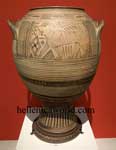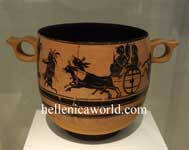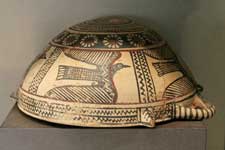.


Administrative Region : Central Greece
Regional unit : Voiotia
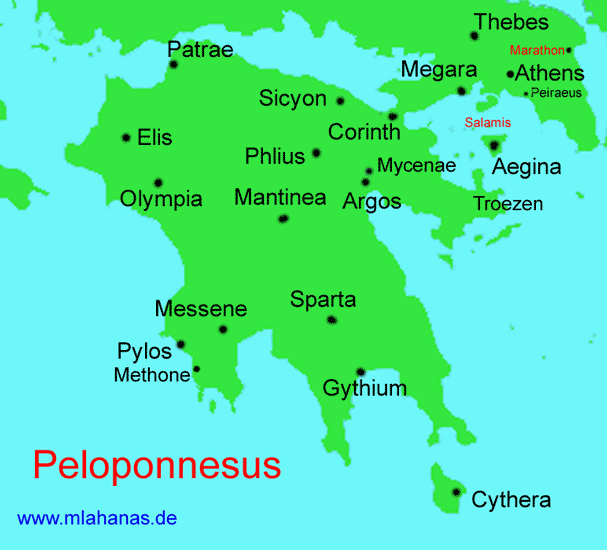
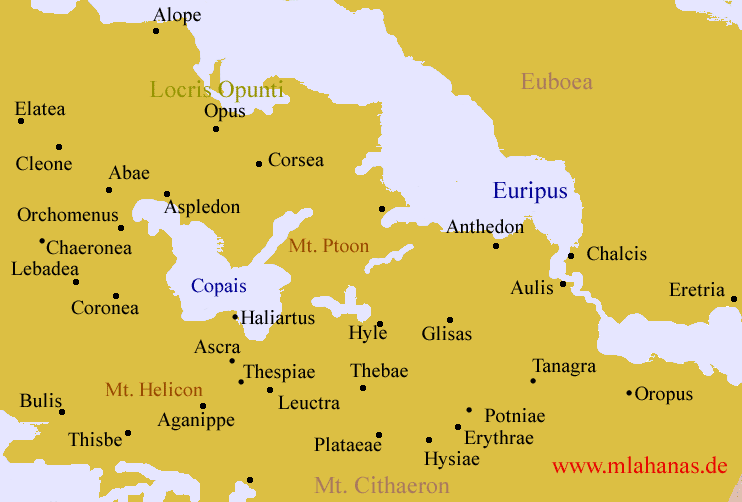
Who built Thebes of the seven gates ?
In the books you will read the names of kings.
Did the kings haul up the lumps of rock ?
Bertolt Brecht Questions From a Worker Who Reads
Thebes (play /ˈθiːbz/, US dict: thēbz′; Greek: Θῆβαι, Thēbai, [tʰɛ̂ːbaj]; Modern Greek: Θήβα, Thiva, [ˈθiva]) is a city in Greece, situated to the north of the Cithaeron range, which divides Boeotia from Attica, and on the southern edge of the Boeotian plain. It played an important role in Greek myth, as the site of the stories of Cadmus, Oedipus, Dionysus and others. Archaeological excavations in and around Thebes have revealed a Mycenaean settlement and clay tablets written in the Linear B script, indicating the importance of the site in the Bronze Age. In ancient times, Thebes was the largest city of the region of Boeotia and was the leader of the Boeotian confederacy. It was a major rival of ancient Athens, and sided with the Persians during the 480 BC invasion under Xerxes. Theban forces ended the power of Sparta at the Battle of Leuctra in 371 BC under the command of Epaminondas. The Sacred Band of Thebes (an elite military unit) famously fell at the battle of Chaeronea in 338 BC against Philip II and Alexander the Great. Prior to its destruction by Alexander in 335 BC, Thebes was a major force in Greek history, and was the most dominant city-state at the time of the Macedonian conquest of Greece. During the Byzantine period, the city was famous for its silks. The modern city contains an Archaeological Museum, the remains of the Cadmea (Bronze Age and forward citadel), and scattered ancient remains. Modern Thebes is the largest town of Boeotia. It is situated at highway E962, some 4 km south of the junction with E75.
History
Mythic record
For a discussion of the many mythical kings of Thebes and their individual feats, see Theban kings in Greek mythology.
The record of the earliest days of Thebes was preserved among the Greeks in an abundant mass of legends which rival the myths of Troy in their wide ramification and the influence which they exerted upon the literature of the classical age. Five main cycles of story may be distinguished:
The foundation of the citadel Cadmeia by Cadmus, and the growth of the Spartoi or "Sown Men" (probably an aetiological myth designed to explain the origin of the Theban nobility which bore that name in historical times);
The building of a "seven-gated" wall by Amphion, and the cognate stories of Zethus, Antiope and Dirce;
The tale of Laius, whose misdeeds culminated in the tragedy of Oedipus and the wars of the "Seven Against Thebes", the Epigoni, and the downfall of his house; Laius' pederastic rape of Chrysippus was held by some ancients to have been the first instance of homosexuality among mortals, and may have provided an etiology for the practice of pedagogic pederasty for which Thebes was famous. See Theban pederasty and Pederasty in ancient Greece for detailed discussion and background.
The immolation of Semele and the advent of Dionysus; and
The exploits of Heracles.
Early history

The Greeks attributed the foundation of Thebes to Cadmus, a Phoenician king from Tyre (now in Lebanon) and the brother of Queen Europa. Cadmus was famous for teaching the Phoenician alphabet and building the Acropolis, which was named the Cadmeia in his honor and was an intellectual, spiritual, and cultural center. Archaeological excavations in and around Thebes have revealed cist graves dated to Mycenaean times containing weapons, ivory, and tablets written in Linear B. Its name in the local tablets, and in tablets found in Mycenae, was transliterated TE-QA-I (TH Ft 140.1) understood to be read as *Tʰēgʷai (Ancient Greek Θῆβαι Thēbai), and TE-QA-DE (MY X 508; TH Wu 65.a) for *Tʰēgʷasde (Ancient Greek Θήβασδε Thēbasde).[CN]
Theban workshop (Oinochoe type), 7th century BC.
It seems safe to infer that *Tʰēgʷai was one of the first Greek communities to be drawn together within a fortified city, and that it owed its importance in prehistoric days — as later — to its military strength. Deger-Jalkotzy claimed that the statue base from Kom el-Hetan in Amenhotep III's kingdom (LHIIIA:1) mentions a name similar to Thebes, spelled out quasi-syllabically in hieroglyphs as d-q-e-i-s, and considered to be one of four tj-n3-jj (Danaan?) kingdoms worthy of note (alongside Knossos and Mycenae). *Tʰēgʷai in LHIIIB lost contact with Egypt but gained it with "Milatos" (Hit. Milawata) and "Cyprus" (Hit. Alasiya). In the late LHIIIB, according to Palaima ("Sacrificial Feasting", Hesperia 73, 2004), *Tʰēgʷai was able to pull resources from Lamos near Mount Helicon, and from Karystos and Amarynthos on the Greek side of the isle of Euboia.
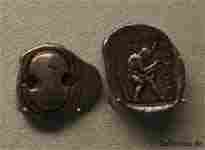
As a fortified community, it attracted attention from the invading Dorians, and the fact of their eventual conquest of Thebes lie behind the stories of the successive legendary attacks on that city.
The central position and military security of the city naturally tended to raise it to a commanding position among the Boeotians, and from early days its inhabitants endeavoured to establish a complete supremacy over their kinsmen in the outlying towns. This centralizing policy is as much the cardinal fact of Theban history as the counteracting effort of the smaller towns to resist absorption forms the main chapter of the story of Boeotia. No details of the earlier history of Thebes have been preserved, except that it was governed by a land-holding aristocracy who safeguarded their integrity by rigid statutes about the ownership of property and its transmission.
Archaic and classical periods
Main article: Ancient Thebes (Boeotia)
In the late 6th century BC, the Thebans were brought for the first time into hostile contact with the Athenians, who helped the small village of Plataea to maintain its independence against them, and in 506 BC repelled an inroad into Attica. The aversion to Athens best serves to explain the apparently unpatriotic attitude which Thebes displayed during the Persian invasion of Greece (480–479 BC). Though a contingent of 400 was sent to Thermopylae and remained there with Leonidas until just before the last stand when they surrendered to the Persians,[1] the governing aristocracy soon after joined King Xerxes I of Persia with great readiness and fought zealously on his behalf at the Battle of Plataea in 479 BC. The victorious Greeks subsequently punished Thebes by depriving it of the presidency of the Boeotian League and an attempt by the Spartans to expel it from the Delphic amphictyony was only frustrated by the intercession of Athens. In 457 BC Sparta, needing a counterpoise against Athens in central Greece, reversed her policy and reinstated Thebes as the dominant power in Boeotia. The great citadel of Cadmea served this purpose well by holding out as a base of resistance when the Athenians overran and occupied the rest of the country (457–447 BC). In the Peloponnesian War the Thebans, embittered by the support which Athens gave to the smaller Boeotian towns, and especially to Plataea, which they vainly attempted to reduce in 431 BC, were firm allies of Sparta, which in turn helped them to besiege Plataea and allowed them to destroy the town after its capture in 427 BC. In 424 BC at the head of the Boeotian levy they inflicted a severe defeat upon an invading force of Athenians at the Battle of Delium, and for the first time displayed the effects of that firm military organization which eventually raised them to predominant power in Greece.
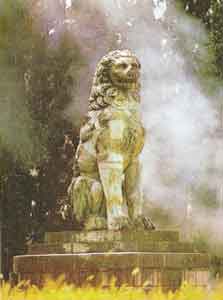
The lion monument at Chaeronea in honor of the members of the Sacred Band of Thebes who all died in Battle of Chaeronea
After the downfall of Athens at the end of the Peloponnesian War, the Thebans, having learned that Sparta intended to protect the states which they desired to annex, broke off the alliance. In 404 BC they had urged the complete destruction of Athens, yet in 403 BC they secretly supported the restoration of its democracy in order to find in it a counterpoise against Sparta. A few years later, influenced perhaps in part by Persian gold, they formed the nucleus of the league against Sparta. At the Battle of Haliartus (395 BC) and the Battle of Coronea (394 BC) they again proved their rising military capacity by standing their ground against the Spartans. The result of the war was especially disastrous to Thebes, as the general settlement of 387 BC stipulated the complete autonomy of all Greek towns and so withdrew the other Boeotians from its political control. Its power was further curtailed in 382 BC, when a Spartan force occupied the citadel by a treacherous coup-de-main. Three years later, the Spartan garrison was expelled and a democratic constitution was set up in place of the traditional oligarchy. In the consequent wars with Sparta, the Theban army, trained and led by Epaminondas and Pelopidas, proved itself formidable (see also: Sacred Band of Thebes). Years of desultory fighting, in which Thebes established its control over all Boeotia, culminated in 371 BC in a remarkable victory over the Spartans at Leuctra. The winners were hailed throughout Greece as champions of the oppressed. They carried their arms into Peloponnesus and at the head of a large coalition, permanently crippled the power of Sparta, in part by freeing many helot slaves, the basis of the Spartan economy. Similar expeditions were sent to Thessaly and Macedon to regulate the affairs of those regions.
However, the predominance of Thebes was short-lived as the states which she protected refused to subject themselves permanently to her control. Their renewed rivalry with Athens, who had joined with Thebes in 395 BC in fear of Sparta, but since 387 BC had endeavored to maintain the balance of power against her ally, prevented the formation of a Theban empire. With the death of Epaminondas at the Battle of Mantinea (362 BC) the city sank again to the position of a secondary power. In a war with the neighboring state of Phocis (356–346 BC) it could not even maintain its predominance in central Greece, and by inviting Philip II of Macedon to crush the Phocians it extended that monarch's power within dangerous proximity to its frontiers. A revulsion of feeling was completed in 338 BC by the orator Demosthenes, who persuaded Thebes to join Athens in a final attempt to bar Philip's advance upon Attica. The Theban contingent lost the decisive battle of Chaeronea and along with it every hope of reassuming control over Greece. Philip was content to deprive Thebes of her dominion over Boeotia; but an unsuccessful revolt in 335 BC against his son Alexander the Great was punished by Alexander and his Greek allies by the destruction of the city, except, according to tradition, the house of the poet Pindar and the temples.
While he was triumphantly campaigning north, the Thebans and Athenians rebelled once more. Alexander reacted immediately, but, while the other cities once again hesitated, Thebes decided to resist with the utmost vigor. This resistance was useless, however, as the city was razed to the ground amid great bloodshed and its territory divided between the other Boeotian cities. Moreover, the Thebans themselves were sold into slavery.[2] Alexander spared only priests, leaders of the pro-Macedonian party and descendants of Pindar, whose house was the only one left standing. The end of Thebes cowed Athens into submission. According to Plutarch, a special Athenian embassy, led by Phocion, an opponent of the anti-Macedonian faction, was able to persuade Alexander to give up his demand for the exile of leaders of the anti-Macedonian party, most particularly Demosthenes.[3]
Hellenistic and roman periods
Was destroyed in Hellenistic period by Alexander the Great. The city was razed and its inhabitants sold into slavery or slaughtered.
Byzantine period
During the early Byzantine period it served as a place of refuge against foreign invaders. From the 10th century, Thebes became a centre of the new silk trade, its silk workshops boosted by imports of soaps and dyes from Athens. The growth of this trade in Thebes continued to such an extent that by the middle of the 12th century, the city had become the biggest producer of silks in the entire Byzantine Empire, surpassing even the Byzantine capital, Constantinople. The women of Thebes were famed for their skills at weaving. Theban silk was prized above all others during this period, both for its quality and its excellent reputation.
Though severely plundered by the Normans in 1146, Thebes quickly recovered its prosperity and continued to grow rapidly until the dissolution of the Byzantine empire by the Fourth Crusade in 1204.
Latin period
Thanks to its wealth, the city was selected by the Frankish dynasty de la Roche as its capital. In 1311 it was used as a capital by the short-lived state of the Catalan Company.
In 1379, the Navarrese Company took the city with the aid of the archbishop Simon Atumano.
Portions of the historical section were taken from the 1911 Encyclopedia Britannica.
Latin hegemony in Thebes lasted to 1458, when the Ottomans captured it. The Ottomans renamed Thebes "İstefe" and managed it until 1829 (nominally to 1832) except for a Venetian occupation between 1687-1699.
Present day
Today, Thebes is a bustling market town, known for its many products and wares. Until the 1980s it had a flourishing agrarian production with some industrial complexes. However during the late 1980s and 1990s the bulk of industry moved further south, closer to Athens. Tourism in the area is based mainly in Thebes and the surrounding villages, where a lot of places of interest related to antiquity exist (for example the place where the Battle of Plataea took place) but it is still in an infant state. The proximity to other, more famous travel destinations, like Mt Athens and Chalkis, and the undeveloped prospect of one of the biggest archaeological sites in Greece have kept the tourist numbers low.
Municipality
The municipality Thebes was formed at the 2011 local government reform by the merger of the following 4 former municipalities, that became municipal units:[4]
Plataies
Thebes
Thisvi
Vagia
Notable people
Ancient
Epaminondas (c. 418-362BC) general and statesman
Aristides (4th century BC) painter
Nicomachus (4th century BC) painter
Crates of Thebes (c. 365-c. 285 BC) Cynic philosopher
Kleitomachos (3rd century BC) athlete
Pindar (c. 522–443 BC), poet
Modern
Haris Alexiou (1950-), singer
Panagiotis Bratsiotis, theologian
Theodoros Vryzakis (c. 1814-1878) painter
See also
Boeotia
Graiki
Sacred Band of Thebes
List of traditional Greek place names
Theban pederasty
Bibliography
Herodotus "The Histories of Herodotus"
Angold, Michael - "The Byzantine Empire, 1025-1204"
References
^ Herodotus Bibliography VII:204 ,222,223.
^ Alexander the Great. Encyclopædia Britannica.
^ Plutarch. Phocion. p. 17.
^ Kallikratis law Greece Ministry of Interior (Greek)
Bibliography
Herodotus "The Histories of Herodotus"
Notes
- 1 Herodotus Bibliography VII:205 ,222,223.
|
Municipalities and communities of the Boeotia (Voiotia) Prefecture
Akraifnia | Aliartos | Arachova | Chaironeia | Davleia | Dervenochori | Distomo | Koroneia | Livadeia | Oinofyta | Orchomenos | Plataies | Schimatari | Tanagra | Thebes | Thespies | Thisvi | Vagia |
| Municipal unit Thivaion |
|---|
| Municipal Community Thivaion |
| Thives (Θήβαι, αι) |
| Community Ampelochori |
| Ampelochori (Αμπελοχώρι, το) |
| Community Eleonas |
| Eleonas (Ελεών, ο) |
| Community Mouriki |
| Καστρί, το |
| Mouriki (Μουρίκι, το) |
| Platanakia (Πλατανάκια, τα) |
| Community Neochoraki |
| Neochoraki (Νεοχωράκι, το) |
| Community Ypato |
| Μονή Μεταμορφώσεως Σωτήρος Σαγματά, η |
| Ύπατο, το |
Greece :
A - B - C - D - E - F - G - H - I - J - K - L - M -
N - O - P - Q - R - S - T - U - V - W - X - Y - Z
| Ancient Greece
Science, Technology , Medicine , Warfare, , Biographies , Life , Cities/Places/Maps , Arts , Literature , Philosophy ,Olympics, Mythology , History , Images Medieval Greece / Byzantine Empire Science, Technology, Arts, , Warfare , Literature, Biographies, Icons, History Modern Greece Cities, Islands, Regions, Fauna/Flora ,Biographies , History , Warfare, Science/Technology, Literature, Music , Arts , Film/Actors , Sport , Fashion --- |
Retrieved from "http://en.wikipedia.org/"
All text is available under the terms of the GNU Free Documentation License


